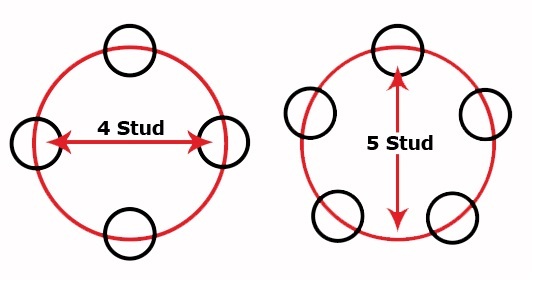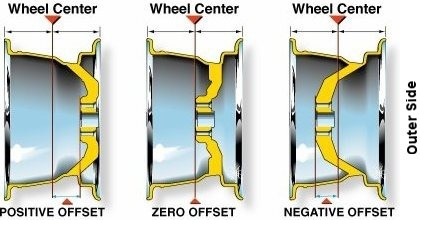Price Match
Now via Live Chat
Wheel PCD and Offset explained:
PCD is the amount of mounting holes in the wheel and the width apart of the mounting holes. Offset is the distance of the hub mounting surface to the centre line of the wheel, see below for a full explanation.
These measurements are required when fitting aftermarket or non standard wheels.
If the PCD of the wheel does not match the PCD of the hub, the wheel bolts will not line up.
If the Offset is wrong then the wheel may foul on the bodywork or stick out too far outside the wheel arch.
Before buying any wheels check the wheel PCD and Offset so that you know they are going to fit your car.
PCD stands for Pitch Circle Diameter and is the diameter in mm of a circle drawn through the centre of wheel bolt holes. The PCD is referred to as the amount of holes x the diameter, so a standard late Beetle steel is a “4 x 130” for example.
4 stud wheels are simple to measure as the bolt holes are opposite each other.
5 stud wheels are measured from the top bolt to the lowest point of the arc in a circle.

Wheel Offset
Offset is the distance from the hub mounting surface to the centre line of a wheel. Offset is measured in mm and results in a positive, negative or zero offset.
Positive offset is when the hub mounting surface is toward the front or face of the wheel.
Negative offset is when the hub mounting surface is toward the back or brake side of the wheel (deep dish).
Zero offset is when the hub mounting surface is even with the centre line of the wheel.

So just to confirm to everyone. A wheel with positve offset (+) will tuck the wheels inside the front wings and closer to the bodywork. A wheel with negative offset (-) will push the wings outside of the wings away from the bodywork.
ET is commonly used when talking offset, this is from the German “EinpressTiefe” which translates as insertion depth.
Once you are happy that the wheel PCD and Offset are correct for your purpose, then you’re ready to order a new set of wheels!
Another thing to watch out for is the type of bolt you are going to use. A lot of wheels come complete with bolts (or nuts), but this is not a guarantee that they are suitable for your car.
The standard hubs on a Volkswagen are either 12mm (M12) or 14mm (M14). Both styles have a 1.5mm pitch.
The seat of a wheel bolt (or wheel nut) can be either a tapered or radius seat. As a general rule of thumb most steel wheels use a radius seat. This is when the surface of the bolt that touches the wheel is slightly curved or bowl shaped.
Most alloy wheels use a tapered seat. This is when the surface of the bolt that touches the wheel is straight and tapers in towards the thread. Original Porsche alloy wheels however use a radius seat so make sure to check.
You should not use a radius bolt on a tapered wheel seat and vice versa as the bolt wheel will not centre correctly onto the wheel and may come lose.
When fitting wheels onto a brake drum make sure that the bolts are the correct length. They should enter into the brake drum enough to safely hold the wheel on. Make sure the bolts are not too long, if they are when the wheel is rotated it will damage all the brakes and brake fittings inside the drum. After fitting a wheel you should always rotate it slowly while it is still in the air. If the wheel turns freely it’s ok, if it catches on anything then remove the wheel bolts and cut them down (or buy shorter bolts).
The following steel wheels were fitted as standard to the vehicle from the factory. There were some special models manufactured that used different wheels so this information should be used as a guide only.
August 1968 to February 1972 were installed with a 4 stud (4×130 PCD) steel wheel that was 15″ in diameter and 4″ wide (4Jx15). The offset of this wheel was ET40.
March 1972 to July 1973 were installed with a 4 stud (4×130 PCD steel wheel that was still 15″ in diameter but was slightly wider at 4 1/2″ (4.5Jx15). The offset of this wheel was ET34.
August 1973 to the end of production were installed with one of two options. There was a 4 1/2″ wide wheel with and offset of ET41 or a 5 1/2″ wide wheel with an offset of ET34.